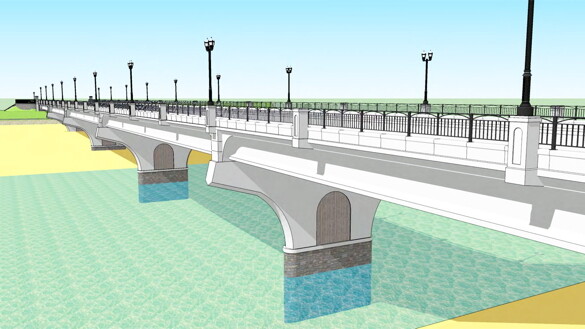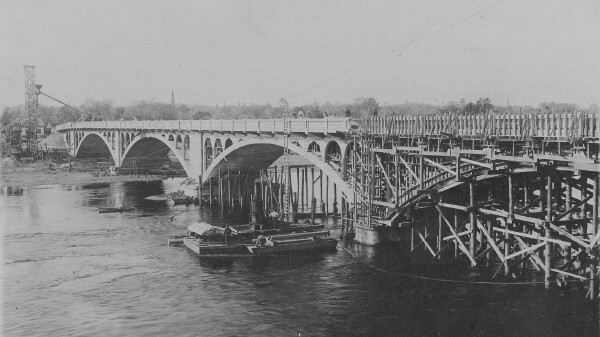Building It Better
new Water Street bridge will have classic look, bike- and walk-friendly design

decorative pedestals, balusters, and arch-like elements.
A glance at pictures of the bridges that once crisscrossed Eau Claire’s rivers reveals that such spans of wood, steel, and stone can be more than simply utilitarian: They can be beautiful, too. Those who traversed above the city’s waters in the late-19th and early-20th century did so on bridges set atop majestic arches and framed by classically styled balustrades. As these bridges were replaced, however, the architecture became more mundane and cost-conscious. With the exception of the Dewey Street bridge over the Eau Claire River, Eau Claire’s modern vehicle bridges are remarkable for being unremarkable.
This long-term design trend will change if current plans are realized. The new bridge that will carry travelers across the Chippewa River to Eau Claire’s Water Street will be more attractive, wider, safer, and more accommodating for bicyclists and pedestrians. While construction won’t begin until the fall of 2015, preliminary drawings show a bridge with classic design elements including subtle archways, decorative pedestals, and concrete cast to resemble balustrades – those rows of short, ornamental columns topped by railings you see on historic structures.
“This is in a neighborhood in a surrounding community where the aesthetic features were important,” explains Tara Weiss, project manager for the state Department of Transportation. The bridge connects Summit Avenue, which runs through the Third Ward, with its historic turn-of-the-last-century homes, to Water Street, which is adjacent to the Historic Randall Park Neighborhood. The bridge will cost an estimated $7 million, and because of the location and scope of the project, about 1.5 percent of that total will be allocated to what the DOT calls “community sensitive solutions” – in other words, making sure the structure doesn’t stick out like a sore architectural thumb.
The existing Water Street bridge was built in 1947, and after nearly 70 years it’s beginning to degrade, Weiss says. In addition, it’s difficult to retrofit with modern safety features, such as higher railings. (Anyone who’s bicycled or walked across the bridge knows the current railings seem uncomfortably low.) While the bridge isn’t yet dangerous, no one wants a repeat of what happened with its predecessor: That bridge, built in 1914, collapsed in 1945 after erosion around one of its piers caused its surface to buckle sharply.

The DOT held several sessions in late 2013 to gather public input about the new bridge project. (Another session will be held in late fall or early winter this year.) Based on the feedback they received, Weiss said planners tweaked some of their designs, including reducing the height of the concrete parapet and raising the height of the railing. These modifications should improve the visibility of the river for all those who use the bridge. “People feel like looking at that river is an indication of the seasons,” she says.
The DOT also got a lot of feedback about pedestrian and bike usage of the bridge. In response, the bridge will include 4.5-foot-railings, five-foot-wide bike lanes in both directions as well as eight-foot-wide sidewalks for pedestrians. (Currently, bikes and pedestrians share the same narrow sidewalks.) The finished bridge will be nearly 700 feet long and 62 feet wide.
Unlike most transportation projects inside the city limits, because of the bridge’s size and cost, replacing it is entirely in the DOT’s hands. However, once it is complete, it will belong to the city, which will be responsible for maintaining it. The city will share only a fraction of the cost: an estimated $30,000 for city utility lines that will be attached to the bridge, says city engineer David Solberg. The Eau Claire City Council is expected to consider an agreement with the state about those costs in July. (The city’s Waterways and Parks Commission gave its unanimous approval to the overall bridge plan in May.)
The DOT is scheduled to finalize plans for the bridge by Feb. 1. Bids will be let in July 2015, and construction will start in the fall of 2015 and be finished in August 2016 for the beginning of the school year. Because the existing bridge will be entirely removed, traffic will have to be detoured: Drivers will be encouraged to cross the River on Lake Street, while bikers and walkers can use UW-Eau Claire’s nearby footbridge.
For information and updates on the Water Street bridge replacement project, visit dot.wisconsin.gov/projects/nwregion/waterstbridge/.






















